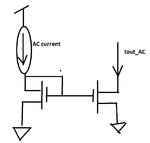bhl777
Full Member level 6
Hi all, I have a question about the transfer function of AC current. If we have a 1:1 current mirror, like the uploaded figure. Then if we inject an AC current at the input, what is the phase shift of the output AC current?
I think the gain would be 1 (0dB) below MHz level, but am not sure how to determine the phase shift between input and output. Is it 0 degree or 180 degree?
Thank you!

I think the gain would be 1 (0dB) below MHz level, but am not sure how to determine the phase shift between input and output. Is it 0 degree or 180 degree?
Thank you!
